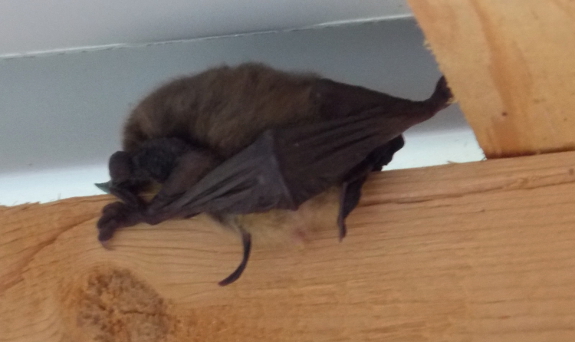
Porch bat

 Despite the fact
that we basically live in a swamp, we don't have a terrible bug
problem. Yes, at dusk, the no-see-ums come out, there's a
mosquito now and then, and the deer flies get bad down in the
floodplain during the dog days of summer. But, generally,
Mark and I can work outside without feeling bombarded by
bloodsuckers.
Despite the fact
that we basically live in a swamp, we don't have a terrible bug
problem. Yes, at dusk, the no-see-ums come out, there's a
mosquito now and then, and the deer flies get bad down in the
floodplain during the dog days of summer. But, generally,
Mark and I can work outside without feeling bombarded by
bloodsuckers.
The dragonflies, I'm
sure, deserve a lot of the bug-control
credit, but so
do the bats. That's why Mark and I were so happy to have a
visitor spending a sunny day hidden above the porch rafters.
"Wouldn't it be nice
if we made a bat box and collected the guano underneath?" Mark
mused. My very-limited experience with bat boxes involved
watching how the boxes around the nature center where I worked as
a high school student always stayed vacant, and my boss telling me
that he'd never seen a bat box used. But the idea is so good, I thought I'd ask
around --- have you ever seen a bat box with a no-vacancy sign out
front? If so, what was the bat box's design?
Want more in-depth information? Browse through our books.
Or explore more posts by date or by subject.
About us: Anna Hess and Mark Hamilton spent over a decade living self-sufficiently in the mountains of Virginia before moving north to start over from scratch in the foothills of Ohio. They've experimented with permaculture, no-till gardening, trailersteading, home-based microbusinesses and much more, writing about their adventures in both blogs and books.
Want to be notified when new comments are posted on this page? Click on the RSS button after you add a comment to subscribe to the comment feed, or simply check the box beside "email replies to me" while writing your comment.

I built a couple boxes years ago with a scout group. No activity, even though little brown bats were in the area. I followed proper placing, to get morning sun, etc., etc. But no bats in either house. I still have them after moving 5 years ago, but haven't set them up again. They were constructed from 1x6 rough-sawn lumber, were about 2' tall. We scratched up the insides to give even more toe-holds.
I've heard bats don't eat many mosquitoes, mostly moths (not that that isn't good), just different from what many have been told or believe.
Bats always make me happy!n I'm not sure why, partly for insect control, but I also think they are very cute.
Hey! I am a frequent reader but I tend to lurk rather than comment. However, I really like bats, and have been wishing I lived in a house and not a city apartment so that I could have a bat box (for the summer at least - I believe our bats migrate away from Scandinavia in the winter, it being too cold).
This website had some good links and explanations about how to make a bat house: http://batworld.org/
P.S. Your visitor is absolutely adorable!
Bats are the most common source of human rabies in the United States. Be especially careful when bats are acting sick, incapable of flight, or not afraid of humans. Transmission of the virus happens when saliva (or infected brain tissue) of bats breaks the skin. When "sick" bats were tested, approximately 6% of tested positively for rabies. In the US, in 2010, approximately 6100 people were treated for rabies... unfortunately two were not treated in time: they died.
When placing bat boxes, you might want to make sure that the guano falls well away from habitable areas... and if you are determined to handle bat guano in spite of rabies, wear gloves and keep it out of contact with eyes, mouth, mucus membranes and non-intact skin.
I'll help a sick bird, a sick bat; not so much.